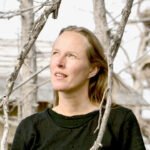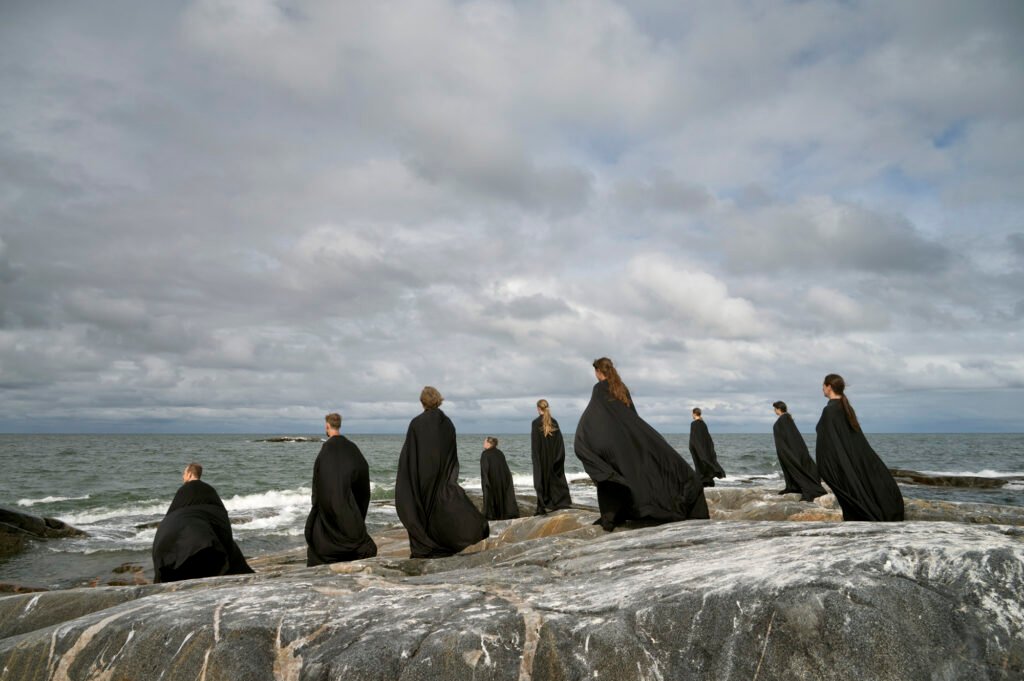Chorus sinensis is an audio-visual choral work dedicated to the Great Cormorant (Phalacrocorax carbo sinensis). The artwork emerges from the bordering territories of Great Gormorants and humans in the coastal areas of Bothnian Sea in western Finland. The situation between cormorants and humans in Finland provides a vivid demonstration of human-avian conflict, where birds are met with antipathy and a lack of understanding of the contextual drivers. This Nest translates the ecological debate raised by cormorants through the lens of art and culture, thereby generating new perspectives for public contemplation.
Chorus sinensis is conceived and curated by Ulla Taipale and combines moving images, photographs and recordings by artist Jan Eerala with a choral composition by composer and sound artist Lau Nau and the essay The Great Cormorant – a Bird Worthy of a Song by literary scholar Karoliina Lummaa. The audio-visual choral work and photographs are shown as an exhibition with the possibility of a live performance of the choir, depending on the venue.
The idea was to commune and applaud the Great Cormorants by giving them their first and only song. To quote Karoliina Lummaa: “Everything that is important gets a story, a song of its very own. Nature and all its animals and plants are meaningful to us, and that meaning is reflected in art and culture. And what has been depicted and written about remains in our minds as something worth cherishing”.
The working group also includes Merja Markkula, a biologist and artist who designed the choir costumes, as well as the 8-member Poseidon Choir: Kristina Bakić, Eeva Bergroth, Anna Jussilainen, Tuija Kuoppamäki, Aleksi Pihkanen, Sami Siitojoki, Teemu Suuntamaa, Susanne Ådahl and Iina Ukkonen. The National Cormorant Working Group and numerous Finnish cormorant researchers also provided their support and expertise in order to realise this Nest.
In August 2021, the choir and working team travelled to the outer archipelago of Luvia in the Bothnian Sea to photograph the choir’s landing and to film a performance of two specially composed choral pieces: Chorus sinensis and Elements. The recordings happened on a rocky island called Pohjankalliot, which is a habitat of cormorants and other seabirds. In October 2021, a studio recording of the choral work took place, and the first exhibition of the work was shown at Pori Art Museum in June-September 2022, consisting of the video and photographic works, texts and a real nest of a Great Cormorant, exhibited with a special permission of Finnish Centre for Economic Development, Transport and the Environment. There was also a live choir performance for the finale of the show.The exhibition was very well received with many visitors, among them hundreds of school kids.
Chorus sinensis has since been invited to the Stazione di Topoló, Art Festival in Italy in July 2022, presented as the IHME Helsinki online lecture in November 2022, shown at Mänttä Art Festival during summer 2023 and had a screening during the show “I Love Seagulls” at Tromsø Art Society in Norway, August 2023. Chorus sinensis is due to show in March 2024 in Hanaholmen Cultural Centre in Espoo, Finland and in Österängens konsthall in Jönköping, Sweden in summer 2024.
The curator for this Nest is Ulla Taipale.
All photos on this page and the Chorus sinensis video has been taken by the artist Jan Erala.
BACKGROUND FOR THE PROJECT
Between 2019 and 2022, our team tracked cormorant communities in their nesting areas in the Bothnian Sea and Archipelago. They were recorded on rugged, distant outer islets, in a port area reserved for industrial activity, and on an inland lake where they nested for the first time in the summer of 2020.
Living on these islands, the colonies carefully build nests from branches and twigs gleaned from far and wide. In the nests, they lay their eggs and hatch their young, whilst fishing in nearby waters. They migrate in the autumn, often returning to the same islands the following spring to nest once again. Cormorants do not attack people nor other predators to defend their nests and offspring.
However, cormorants are unwelcome in human territory. Their droppings transform the colour of their nesting island to brilliant white over the summer; this does not interfere with their lives but offends local people. As a protected seabird the number of cormorants have risen during the last 20 years and their population is stable. After the nesting season and the birds fertilising the terrain, the barren cormorant islands convert to beautiful meadows and become a flowering oasis in the middle of the Baltic Sea.
The whole black ragged being that kills the pleasing greenery and affects the fish – this is how a cormorant can be described. Black bird; white feces; black and white image of a bird. The blackness of a cormorant is dirty evil black, its skill as a fisherman is catastrophic greed, its life in the colony is polluting and destructive. This is what it looks like when you look at a bird and its nature from a particular angle, looking for signs of harm and disorder. Are other stories and images of cormorants possible? Is this bird worthy of a human song? Could there be fairytales about a bird that never sang? A bird whose life bothers some? What would be the story of a cormorant, the fairytale that could be told tomorrow?
— Karoliina Lummaa, Great Cormorant, Worth a Song, 2021
Participants in Chorus sinensis

Ulla Taipale (FI)
Curator
Ulla Taipale is Finnish curator and artist who works internationally. She is specially interested in enhancing cultural and ecological biodiversity through art & science interventions, and in building bridges between art and science communities, facilitating dialogue between artists, creators, scientists, and the general public. She has a BSc in Environmental Engineering and an MA in Visual Cultures, Curating and Contemporary Art from Aalto University, Finland. She works currently as Art&Science curator of Climate Whirl Art program at INAR / University of Helsinki.
www.capsula.fi
melliferopolis.net
www.theotherside.fi
www.climatewhirl.fi

Laura Naukkarinen (FI)
Composer / Artist
Laura Naukkarinen is a Finnish composer and performer who works with analogue synthesizers, acoustic sounds and field recordings. Her work comprises a range of solo albums under the moniker Lau Nau, scores for films and performing arts, multi channel sound installations and workshops.
launau.com

Jan Erala (Fi)
Artist / Photographer
Jan Eerala, born in 1948, working and living in town Pori in Western Finland, is a self taught visual artist operating with video, sound and photography. His lifelong production mirrors the relationship between nature and humans, often with a sense of rustic humor.
www.eerala.com

Merja Markkula (FI)
BIOLOGIST / ARTIST
Merja Markkula has always been eager to become absorbed in new challenges. She first studied biology, agriculture, and experimental embryology. As a scientist she worked in several universities studying reproduction. Twenty years ago she left science and devoted to art, using mainly, but not only, textile materials. Chorus sinensis costumes are designed by her.
Merja Markkula has always been eager to become absorbed in new challenges. She first studied biology, agriculture, and experimental embryology. As a scientist she worked in several universities studying reproduction. Twenty years ago she left science and devoted to art, using mainly, but not only, textile materials. Chorus sinensis costumes are designed by her. Ten years ago, National board of antiquates closed the museum in Kuusisto manor in West Coast of Finland. She realized that the valuable cultural history of Kuusisto surroundings, if presented as an equal partner with contemporary art, could have unique, internationally important potential. Since then she dedicates her time for curation of exhibitions and guidelines in Kuusisto Art Manor.

Karoliina Lummaa (FI)
Postdoctoral Researcher
Karoliina Lummaa is a postdoctoral researcher specialised in literary studies and environmental humanities.
Currently, she is affiliated with the University of Turku and to the independent BIOS Research Unit. Lummaa’s publications include research articles and co-edited anthologies on ecocriticism and posthumanism. She is the author of two monographs focusing on Finnish bird poetry and bird cultures.

Great Cormorant (Phalacrocorax carbo sinensis)
Seabird
Us cormorants are a bird species living in most parts of the planet’s marine areas and other waterways. We like living in big colonies together with folks of our kind. Sometimes other sea birds live together or near to our colonies, and we support each other’s lives. In Finland we mostly occupy outer and rocky sea islands where no one else likes living. We enjoy the open skies and the fresh sea breeze and mostly eat small fish such as perches and roaches which we catch by diving.





